

Volume 11, No. 2, Art. 24 – May 2010
Is the Discourse of Hybridity a Celebration of Mixing, or a Reformulation of Racial Division? A Multimodal Analysis of the Portuguese Magazine Afro
José Ricardo Carvalheiro
Abstract: For many years the study of "race" relations was dominated by paradigms—of assimilationism and multiculturalism—which highlighted difference and division (as a problem, or a virtue). In more recent years the idea of racial and cultural mixing—creolization or hybridization—has become an important concept in ethnic and racial studies. The starting point of this article is the observation that the idea of racial and cultural mixture—hybridity or mestiçagem—was a key ideological feature of Portuguese colonialism in its last decades. If hybridity is not therefore a new discourse in Portugal, what is the place for it today and what kind of hybridity is being referred to? What might the Portuguese case tell us about discourses of hybridity more generally? The article explores these questions through a combined visual and linguistic analysis of the lifestyle magazine Afro as a site where contemporary discourses about "race" intertwine.
Key words: "race"; hybridity; discourse; image; post-colonial; minority media; gender
Table of Contents
1. Introduction
3. The "African" Minority in Portugal
4. Afro, a Magazine in the Market
4.1 What does the existence of a lifestyle magazine such as Afro mean?
5. Racial Actors in Visual and Verbal Texts
6. Transnational Representations, "Race" Questions and Hybridity
7. Stories About Mixing: Layers of Discourse
8. Conclusion
For a long time the dominant paradigms on cultural and "race" relations were more concerned to identify situations of diffusion, assimilation or isolation—the main debates were between an assimilationist and multiculturalist outlook—than to think about the dynamics of interaction or fusion, which for the most part went without recognition (YOUNG, 1995). Eventually, post-colonial thinking made hybridity into an important concept. Today we live in a time of accelerating hybrid phenomena, where Diasporas and media play an important role. What is new, according to PIETERSE (2001, p.227), is not hybridity, but a new acknowledgment of it. The new acknowledgment of hybridity is taken as an indication of a deep change in subjectivities and is often correlated with changes in social structures. The starting point of this paper is the observation that the idea of racial and cultural mixture was a key ideological feature of Portuguese colonialism in its last decades. If hybridity is not therefore a new discourse in Portugal, what is the place for it today and what kind of hybridity is being referred to? [1]
I will start the article by briefly retracing the development of the discourses of nation, "race" and culture the Portuguese applied to Africans in colonial times. I will then go on to present the discourse of a contemporary Portuguese media for a minority group, through an examination of the magazine Afro. [2]
2. From Empire to Immigration: Discourses About "Race"
Portugal's relationship to colonial territories is paramount in the country's history and ideology, for the main reason that it is intimately tied to the very survival of an independent nation-state on the fringe of south-western Europe. Colonial ideology and the representation of African natives made by political and intellectual elites throughout the 20th century is a foundational factor in the way the Portuguese give meaning to phenotypes, and particularly for the ways of conceiving "black" people today. However, it is also important to recognize that fundamental ideas about Portuguese national character are rooted in colonial discourses, which decisively built up self-perceptions that differentiate Portugal from other European nations. I try to identify several discourses rooted in colonial history. I think there are legacies from these lines of reasoning in today's ideologies about culture and "race" in Portugal. Of course, there are also influences from today's transnational cultural flows and migration movements, and that will be evident in the case study of the media. [3]
Three discourses can be pointed to as having developed during the last century of Portugal's colonial rule in Africa, until decolonization occurred in 1975. The first one was openly ethnocentric and racist, denying cultural life to the "savages" and pointing to their aversion to work, if not taught and obliged to by Europeans (ALEXANDRE, 2000). For several decades this was largely hegemonic, justifying colonialism as a duty to preserve the "sacred heritage" of a glorious past, in spite of local people. Africans were seen as innately and immutably inferior, in parallel with "scientific" racial theories of the period. Here are rooted ideas of the unavoidable otherness of black people. I call this the difference discourse. [4]
Among many possible examples, Illustration 1 shows a frame from the movie Chaimite (1953), a sort of Portuguese "western" focusing on fights with the tribal leader Gungunhana and the pacification of Mozambican natives at the end of 19th century. As in the whole movie, this frame shows Portuguese characters as singular individuals (face to camera) within personal interactions (talking to each other, family bonds). This is contrasted with the collective representation of indistinguishable native Africans (similar bodies seen from the back), here viewed as a workforce (labor, tools) subordinate to colonial masters (in other sequences, the native Africans are presented in a similar subordinate position as savage fighters whom have to be tamed by the Portuguese army).
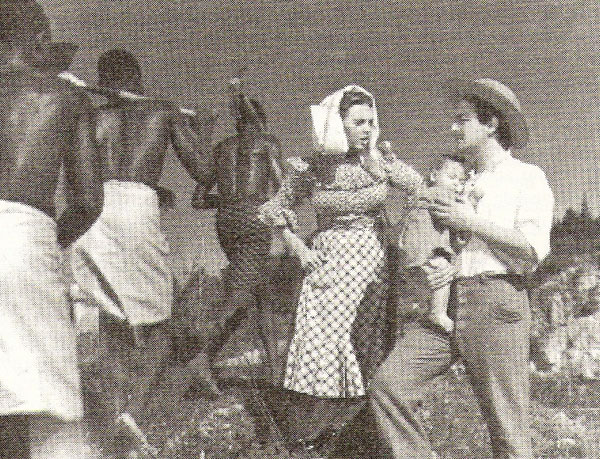
Illustration 1: Jorge BRUM DO CANTO, frame from the movie Chaimite (1953), Cinemateca Nacional [5]
The second discourse, fed by Enlightenment ideas, also appeared in the 19th century. This saw Africans as underdeveloped beings whom could be led to progress by European rule. This was common to other colonial projects that self-proclaimed their "civilizing mission." It is essentially paternalistic and ethnocentric, but it opens the way for ideologies of assimilation. After 1930, colonial law aimed to build up an integrated nation between the motherland and her colonies, recognizing some of the "indigenous" as "assimilated" national citizens, if they adopted certain cultural habits and skills. I call this the assimilation discourse. [6]
Catholic practices and European dressing were considered as identifiable signs of assimilated natives, as in Illustration 2. This at once represents a practice of cultural assimilation and functions as an image of the colonizer's cultural superiority. It could be used both as an exotic display of remote people and as a proof of Portuguese success in "civilizing" them, while also turning into a propaganda image of what in fact has been a very small percentage of assimilated "indigenous."
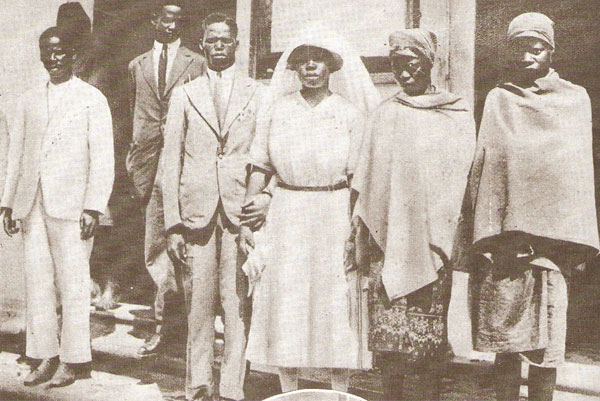
Illustration 2: Religious wedding as image of assimilation discourse (José Manuel OLIVEIRA, Arquivo Histórico Militar, in
BETHENCOURT & CHAUDHURI, 1999, p.268) [7]
A third discourse appeared in the midst of the state's incapacity to perform efficient colonial capitalism. It claimed that the nation's mission was a mystic one, as the Portuguese soul had a special "colonial gift" that allowed a humanitarian relationship with natives which was unknown to other empires. Arising also as a reaction to political humiliation by more powerful empires, this discourse was intended to mark a supposed moral superiority of Portuguese colonialism compared to other allegedly exploitative and materialistic colonizers. Drawing on the terms of Robert YOUNG (1995, p.5), I call this the interaction discourse. This is a discourse that goes beyond the idea of a strictly unidirectional flow from superior to inferior culture, and admits some African cultures to be part of, and contributors to, the Portuguese nation, even if its ultimate goal was to glorify the European core of the nation, as in 1940 colonial exhibition in Lisbon. [8]
Because each of these discourses kept an anti-egalitarian ethos, none of them comprised ideas of cultural hybridization or racial miscegenation. The ideology of the humanitarian colonizer, mixing discourses about assimilation with the ones about abilities to interact and harmonize, was widespread from the 1930s onwards. These representations were promoted through a variety of officially coordinated media: exhibitions, cinema, radio, newspapers and magazines, posters and postcards, music, theater, painting, literature and school books (MATOS, 2006, p.69). [9]
During the last decades of Portuguese colonialism in Africa, images displaying whites and blacks in interaction, in apparently non ostensible hierarchic ways, started to appear. Illustration 3 is an example of this kind of representation (text says: "Many races—One nation. Whites, blacks and mulattoes everyone is Portuguese"). At first site this image may appear to show black and white soldiers on the same level, however, a closer examination helps point to the inclined body of the white soldier on the right. This works out as a vector (KRESS & VAN LEEUWEN, 2004) indicating action in the picture. The action is towards an apparently younger black boy whom the white soldier is talking to and staring at, thereby exercising power.
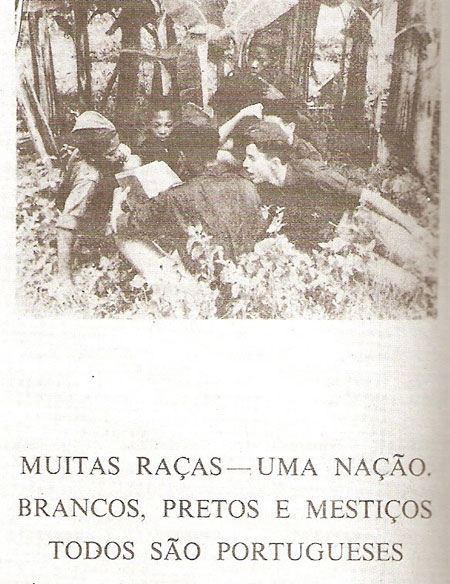
Illustration 3: Back cover of book Casa Lusitana displaying the interaction discourse in the late colonial period (João Carlos
PAULO, Casa Lusitana, in BETHENCOURT & CHAUDHURI, 1999, p.328) [10]
A further step in the "special colonizer" ideology was made from the 1950s onwards, when the state faced increasing international pressure to decolonize and adopted the "Luso-tropicalism" thesis, coined by Brazilian sociologist Gilberto FREYRE (1961). The core of this theory lay in the cultural hybridization and racial miscegenation that FREYRE found to be an outcome of Portuguese colonization in Brazil. FREYRE argued that this could be also applied to other territories because it was due to a "plasticity" of the Portuguese people which gave them an ability for "transculturality" and biological mixing. This gave some theoretical justification to the colonial regime in its rule over African "provinces." The state also developed, in the 1960s, a school version of the Portuguese people and its history overseas that was inspired by Luso-tropicalist ideas (CASTELO, 1998) and led to several forms of multiracial nationalism. I see this as a development within the interaction discourse, enhancing plurality and hybridization, and turning it into a fusion discourse. [11]
Football, and particularly the national team, was to be paramount in the 1960s ideology of racial equality and loyalty under the Portuguese flag. In the 1966 World Cup, both white and black players were presented as "Angolans," meaning from a Portuguese "province" like any other. Black Mozambicans were leaders (as team captain Mário Coluna) or presented as an international symbol for Portugal, as Eusébio on the cover of newsmagazine Flama (Illustration 4) drying tears with the national shirt after a semi-final defeat. This is still today a powerful image in Portuguese nationalism.
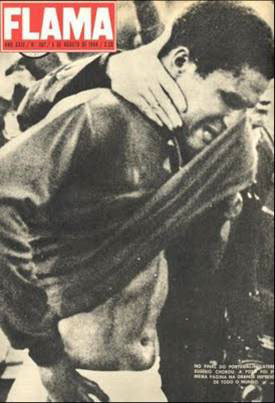
Illustration 4: Portuguese African as national symbol in the 1966 Football World Cup (Nuno FERRARI, in Flama, August 5, 1996, 961, cover, Hemeroteca Municipal de Lisboa [© FPF]) [12]
These discourses coexisted or alternated over time, particularly around miscegenation. Mixing was sometimes magnified but in other periods it was seen as a mark of degradation. On those occasions the African female was pointed to as the evil responsible for racial pollution. It can also be argued that miscegenation was not due to absence of racism but rather was a cause of new racist forms where sexism played a central role by attributing exclusively to the Portuguese colonial male the role of producing the mulatto (SANTOS, 2001). [13]
Ideological discourses have themselves real consequences at the social level. But it seems that, also in practice, ambivalence in "race" relations was a distinctive mark of Portuguese colonialism when compared to other European imperial projects in Africa. Creolization in Portuguese colonies happened besides overwhelming inequalities and racism. It was not dictated as general law but it developed according to local circumstances, some dating from early colonial periods, long before other European powers entered the African continent. For instance, Charles BOXER (1981) points to the frequency of black and mulatto priests in Western Africa since the 16th century. SANTOS points to the lack of actual political power in many regions of the Empire; stating that, for instance in Mozambique, there was a long lasting interaction between Portuguese and local cultures and powers where "commercial interests could not be sustained by a proper imperial power, so the interaction tended to be based on reciprocity and horizontality" (2001, p.55). Also the lack of European people, especially women, prompted individuals to miscegenation, and the local administrations to pragmatism, as the only way to carry on colonial rule (RUSSEL-WOOD, 1998). [14]
In some places, like Cape Verde, recognition of "mixed-race" children by white parents started from the outset, leading to a creolized culture and society. But in other places, like Angola, miscegenation was never high, neither was assimilation: only 1% of the "indigenous" had turned into "assimilated" by the 1960s. Racial barriers did not operate there, as they did in the British Empire. As the proportion of colonizers rose, however, the capital Luanda became more of a city made of segregated residential blocks of Europeans, Africans, and mestiços ("mixed people"), which comprised part of a color hierarchy, rather than forming part of an equality system (HENRIQUES, 1999). In 1958 the future Minister of the Colonies in SALAZAR's Government argued in favor of interracial marriages (in ALMEIDA, 2000, p.179).1) The argument is a significant historical fact, but it never matched the reality of Angola or Mozambique. Creoles from Cape Verde were hired for administration in other colonies during the 20th century, later becoming part of the post-colonial reflux to Portugal. Nevertheless, it was creolized and culturally hybrid people who composed the leading elite of the independent state of Angola under the Marxist Movimento Popular de Libertação de Angola (MPLA) Party. [15]
Beyond historical analysis, it is the impact of the assimilation and the interaction discourses, more than the scrutiny of facts, that persists in Portugal's collective beliefs and provides a key feature of national ideology, where tolerance and non-racism are supposed to distinguish Portuguese from other Europeans. This ideological belief—about a supposedly unique ability to interact with the ex-colonized other—is rooted deeply enough not to be affected by the actual existence of prejudice towards African immigrants, which researchers have identified as similar to prejudice found in the other European countries (VALA, BRITO & LOPES, 1999). The same incongruence between tolerant self-perception and prejudiced attitudes can be noted in the salience of Africans or blacks as a category of difference (CABECINHAS, 2002). Among the Portuguese today, representations about cultural and ethnic groups show a hierarchical status assigned to "whites," "blacks" and mestiços, The latter category is placed in the middle of the racial hierarchy, significantly above blacks but more distant from the status of the whites than from that of the blacks. [16]
I argue that all the three lines of discourse coexist and compete today within Portuguese society, and—by taking the notion of discourse in a Foucaultian sense—that they also embody practices which make up ideological blocks. These discourses are multimodal, following KRESS and VAN LEEUWEN's (2001) formulation, and they may appear in the mode of verbal language or in many others, such as political decisions or visual images in the press. As examples, Illustrations 5 and 6 represent today's common ways of expressing discourses of difference and assimilation in newspaper images: by separating visually and/or contrasting symbolically people of different phenotypes (Illustration 5); or by displaying minority members in daily actions as common Portuguese individuals (Illustration 6). Illustration 7 shows an example of social actors around whom the media have developed a discourse of fusion in verbal mode. This kind of discourse labels such musical movement as "new miscegenation" and points to this band as proof that "all languages and experiences are important and enriching for Portuguese modernity" (BELANCIANO, 2008).
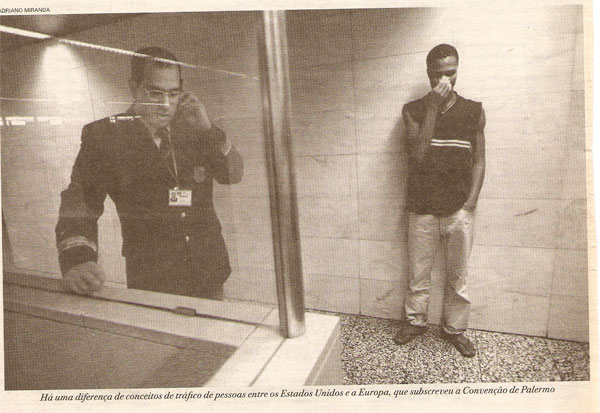
Illustration 5: Difference discourse in a picture about policing borders (Adriano MIRANDA, Público, June 22, 2004, 26 [© Público])
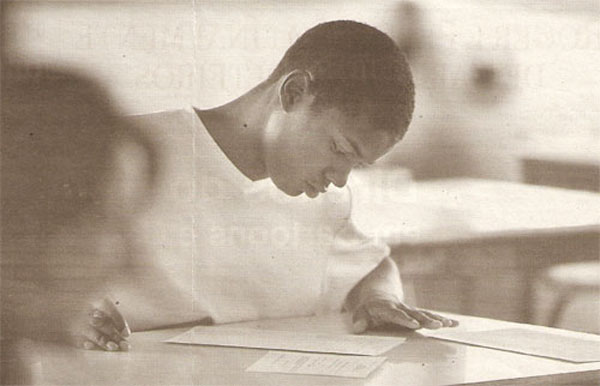
Illustration 6: Assimilation discourse in an image about Portuguese school (Daniel ROCHA, Público, December 12, 2005, 24 [© Público])
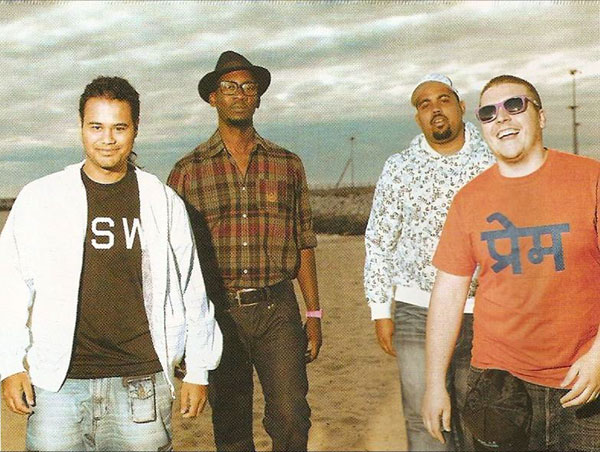
Illustration 7: Portuguese-Angolan band Buraka Som Sistema has fostered fusion discourses in the media (Ricardo CRUZ, Afro, December 2008, 8, 8) [17]
3. The "African" Minority in Portugal
Immigrants from former African colonies have comprised the largest part of the foreign population in Portugal for the last three decades. Although the number of these foreigners has increased over the period (from 27,000 in 1980 to 120,000 in 2008), their share of the total immigrant population has diminished (47% in 1980; 27% in 2008) due to increased flows from other countries, mainly Brazil and eastern European states.2) Official statistics do not count ethnic or racial groups, but only nationalities. The statistics point to 120,000 foreigners from former African colonies in Portugal today, but there is no awareness of a population sub-group such as "black." This administrative practice can be understood as part of the assimilation discourse, erasing "race" from formal political language and rendering phenotypic differences officially unspoken and supposedly not significant within Portugal's national population. Consequently, those immigrants who since the 1970s have acquired Portuguese nationality, and their children who were born or later became nationals (who may be estimated to total some tens of thousands of people of African origin) are not identified as a distinct group. [18]
Another demographic movement tied to decolonization was the half a million former colonizers who entered Portugal in 1975. This made up to 5% of the country's population at the time, and was proportionately larger than any analogous group in other European metropolis (PIRES, 2003). These people have a special link to the idea of Africa, and experienced particular situations in terms of "race" representations and interactions: they personally lived the colonial relationship between whites and blacks in African territories (including colonial war) and also its reversal in the quick decolonization period. [19]
In contemporary Lisbon there are high concentrations of Africans who have migrated to Portugal over the last three decades. These Africans have been pictured as "men who build and women who clean," mainly because of a working-class predominance and limited social mobility among Cape-Verdeans, the largest African community. On the other hand, the so-called "second generation" has higher levels of education, and their members' aspirations are framed much more by urban youth culture than by immigrant culture (MACHADO, 2008). This is especially the case for young women: 24% of the daughters of African migrants currently in employment work as administrative staff; another 56% of young females of African origin are employed in commerce and semi-qualified services. Research on young "blacks" also shows that, within their cultural identities, "race" tends to be less important than national origins (VALA, 2003). A large majority identify themselves as Cape-Verdean, Angolan or Guinean, highlighting affiliations to their parents' countries. A minority point to a black self-identity, while only a few think of themselves primarily as Portuguese. [20]
These factors have to be taken into account when approaching minority media and their audiences. For a magazine that plays strongly with images, and connects the idea of Africa to visual elements such as the phenotype of the people displayed, it is also relevant to consider that the largest part of its potential audience is composed of women of Cape-Verdean origin, a Creole society. In fact, 46% of females from former Portuguese colonies have Cape-Verdean nationality. If we could also count the Portuguese nationals with African family backgrounds, the Cape-Verdean share would likely increase, since it is the oldest immigrant community and one that has produced a large second generation. However, it is also significant that the main share of Cape-Verdean individuals who migrated to Portugal came from Santiago, culturally and racially "the most African" of the countries islands. [21]
4. Afro, a Magazine in the Market
Targeting "the woman of African origin," the magazine Afro reframes notions of "race" and culture, mixture and difference, brought about diversely by several segments of the African diaspora, and also by Portuguese ex-colonial ideology. Because Portuguese colonialism took a specific form, there is a reason to ask whether or not its post-colonial developments have also taken particular forms. In the following analysis, particular attention will be given to the three lines of discourse exposed above, interconnected to questions of class and gender. [22]
Four decades after the beginning of modern labor migration from Africa, the magazine Afro is apparently the first media produced in Portugal for an African audience by members of the same minority and outside the frame of the Portuguese state. Launched at the beginning of 2008, Afro belongs to the Impala press group. Impala was created in Angola by a Portuguese entrepreneur before the country's independence, and later transferred and developed in Portugal. The group owns lifestyle and women's magazines, as well as television guides, a genre extensively consumed in Portugal. [23]
Afro has a small staff, but plural subject positions are involved in the production. The editor is a woman who left Mozambique seven years before (Mozambicans are a tiny community of 3.000 people in Portugal). Some journalists belong to the "second generation": a young male presents himself as someone "with African origins" for whom it's very important "to show Africa to everybody." The director was born in Angola to a Portuguese family. Her discourse is framed by her experience as an ex-colonizer. She says: "I have a very special fondness for Africa" and "I even have an aunt who is mestiça."3) Organizational hierarchies in the staff are themselves an important point here. [24]
4.1 What does the existence of a lifestyle magazine such as Afro mean?
It could be argued that Afro is the kind of media where image constitutes the core of a "thin reality," where the reader is "invited to wander through the environment picking up whatever she finds attractive" (HEBDIGE, 2005, p.108), and where pleasure leads sense in ways separated from judgment or commitment to written ideas. Nevertheless, representation is always made from an ideological point of view (FOWLER, 1991; VAN DIJK, 1997), and the very existence of the magazine means that there is a discourse of difference. Afro is testament that having "African origin" is a significant factor and constitutes a particular category within Portuguese society. [25]
The magazine also has to be put in a certain context of media experience for minority audiences. The possible meaning of Afro in a politics of representation is related to a context in which former colonized populations turn out to be minorities in ex-metropolis, facing everyday images of themselves as subordinated actors, displayed by the majority in the media. It has been pointed out, in several European post-colonial contexts, that black minorities, and especially second generations, feel lack of representation in landscapes monopolized by mainstream national media, where they are mostly absent or stigmatized (ROSS, 2000; MALONGA, 2007; CARVALHEIRO, 2008). This scenario has provoked post-colonial attempts from minorities throughout the West to enhance their points of view, challenging hegemonic discourses or rather building up separate routes. These movements comprise questions from aesthetics to politics and cultural practices, where "race" is present most of the time whether explicitly or not. [26]
If a trace of the subordination of the colonized is their silence as non-agents, reversing that condition in a post-colonial context means finding ways for the ex-colonized to become speaking subjects. It is worth restating, however, that there is a significant difference between media that target minority audiences as public and media that target them essentially as market (GANDY, 2000). In Portugal, the only mass media targeting African migrants have been state-owned radio and television stations. These media conceive African minorities as publics with needs to be served, providing links to countries and cultures of origin. The state-owned stations, however, work under the framework of national policies and their primary function is to enhance Portuguese influence in former African colonies. As a supplementary function they also work as a space for intercommunication and for voicing migrants' demands within the host community. [27]
The competitive environment of late capitalism has driven commercial media to seek out specific groups and sometimes use their own terms of resistance to sell them products, absorbing oppositional viewpoints into the global network of media and cultural consumption (MIRZOEFF, 2002). Consequently, a growing awareness of the market to target specific segments of consumers has widened minorities' chances of being included in strategies designed to capture audiences. These strategies usually assume that media tastes and preferences are similar within groups definable by national origin, ethnicity, "race" or gender (GANDY, 2000). Furthermore, new opportunities for consumption by middle class minority members have meant that, in contrast with overtly political media content, some minority media turned themselves to the world of consumerism. Many people increasingly came to see the use of consumer goods, such as 'ethnic' clothing, as a way of being and belonging, of having an identity and participating in a lifestyle different from the mainstream (LEWIS, 2002). [28]
5. Racial Actors in Visual and Verbal Texts
The analysis of the lifestyle magazine Afro presented in this paper draws on the idea of multimodal discourses by means of combining a visual semiotics approach (KRESS & VAN LEEUWEN, 2004) with a linguistic analysis (VAN LEEUWEN, 1997). This is undertaken within a cultural studies frame with its account of long running processes involving symbolic and power relations (HALL, 1997). The corpus of the analysis is taken from three magazine issues randomly chosen (Numbers 2, 5 and 8). This corpus comes from three different kinds of texts: 1. features with people; 2. reports about specific topics; and 3. images of photo models. Some of the texts and photos arrive through communication and fashion agencies that sell their stories internationally. Others are produced with data and pictures from archives or through research on secondary sources. Some are made in African countries and sent to Lisbon. A number of them have no clear origin, just seeming to float in a sort of common space, just like some people themselves pictured in the magazine, whose place is not definite. For these reasons, Afro can be seen as inserted in a "black Atlantic" (GILROY, 1995) media and fashion circuit. A large part of the magazine, however, is filled with reports about people settled in Portugal. These parts are generated by the magazine's newsroom. [29]
Each person represented on Afro's pages, because of their very presence, is implicitly related to Africa. When the newsroom selects people and issues to be reported on this is because there is something in the topic that can be approached as a reference to African cultures, to African people in Portugal, to the African Diaspora throughout the world or to another sort of connection with the idea of Africa. Within this logic, the set of stories and pictures foregrounds an emphasis on individuals related to the media circuit. Afro avoids issues of cultural contestation or everyday questions such as neighborhood topics (even though its office is located in the zone with the highest proportion of African residents); neither is there a focus on the successes of common people in common jobs, education or civic life (although young women of African descent seem to be at the same time both the main representatives of this success and the magazine's most obvious target). By avoiding social realism the magazine makes its ideological mark. [30]
Taking verbal texts in order to map marks of distinct discourses (difference, assimilation, interaction/fusion), I draw on VAN LEEUWEN's (1997) proposal for analyzing representations of social actors, having in mind that the sense of categories always depends on the context (FOWLER, 1991). That is why, for instance, terms like hyphenated words have to be properly understood in the context of globalization and post-colonialism. When placed within this context it is possible to see if the hyphenated term signals an interaction discourse (when it means association or fusion, as in "Luso-Brazilian food") or rather a difference discourse (when it means differentiation from the dominant pattern, as in "Afro-American woman"). [31]
Starting with the predominant genre in the magazine, the feature story, all the texts represent social actors verbally through individuation, which is common when focusing on publicly known people. These actors are primarily referred to through nomination rather than categorization. This is in contrast with the predominant texts of minorities in newspapers, where it is common to find definitions by category in headlines such as "Residents of Africa Star quarter will soon be forced to quit," "New law makes it easier to hire foreign workers," "Black gangs use Pitbull dogs as weapon." 4) [32]
Texts in Afro always begin by referring to the featured social actor "in terms of his/her unique identity" (VAN LEEUWEN, 1997, p.200), as in the following example: [Title] "Cláudia Semedo: The sweet voice of the radio;" [subheading] "At 25, she already worked on radio, television, cinema, theatre and writing, and she believes she was born to communicate" (Afro, 5, 74). [33]
By enhancing personalization and singularity, the magazine provides two aspects. First, it offers a sense of proximity to the audiences, a set of possible identifications for readers. Second, as stories are always pictures of success, it implicitly sets a general assimilation discourse about Portuguese society. As used here, "assimilation" means more than the cultural accommodation of people from migrant groups, rather it refers to social assimilation often using narratives emphasizing hard work, individual perseverance and long term effort. As in the following lines: "As soon as he arrived he decided that he had to climb up by himself and be a winner in life (…). He worked hard in factories, was doorkeeper in bars and karate trainer, all at once." (Afro, 5, 100) [34]
Another way the text of Afro provides a sense of assimilation is by defining individuals through functional categories, which means their activities, and not natural attributes: "A ten-year career and an enviable curriculum" (Afro, 2, 22); "The analyst of the celebrities' fancy world" (Afro, 5, 68); "She served hamburgers while she studied, then she became a secretary and did a degree in Sociology" (Afro, 8, 58). This kind of definition of social actors tells successive stories of inclusion in business, sports, music or television. [35]
The visual images convey the importance of look, clothes and objects of individuals, who are not to be mistaken as poor immigrants. If something is not connoted in the array of images about racially marked people this is the world of manual labor in which the majority of African immigrants and families live in Portugal. In Illustration 8 (full page photo illustrating a feature report, Afro, 5, 101), the former doorkeeper turned owner of a coffee house chain sits in his elegant salon (set of candles) dressed in a sportive well-off manner (white shirt, large watch). The angle from which the photo was shot, from a slightly lower level, gives the (female) reader a sense of interaction with a man who has risen to a powerful position (KRESS & VAN LEEUWEN, 2004).
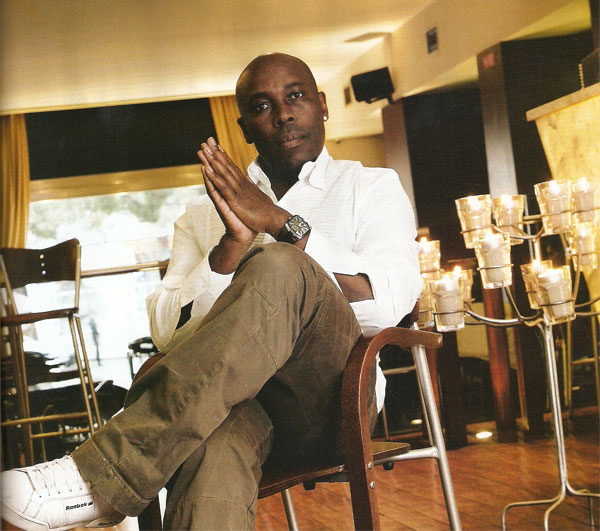
Illustration 8: Looks and scenarios make up the images of successful individuals (Luís AZEVEDO, Afro, June 2008, 5, 101) [36]
Although being part of feature articles about real people, these kinds of images accomplish what John BERGER (2005) said about commercial advertisements: they talk to readers about the future. In the case of Afro, they talk about a possible future of young "African" women in the West, showing them the good life of successful and beautiful people. [37]
It is worth noting that within this politics of representation there is gender difference. In Afro articles, the functionality of men is made clear by the use of nouns: "businessman," "press analyst," football team "captain" (VAN LEEUWEN, 1997, p.202). The representations of men are also predominantly associated with ideas of action ("inventor," "workaholic," "persistent," "intelligent," "taking risks"). The idea of functionality is obtained: 1. through nouns with a verbal basis (to invent, to work, to persist), 2. through the direct use of verbal forms (taking risks) or 3. through a sort of appraisement that connotes with an activity (to think well). Women, on the other hand, are often defined through aspects of the body or senses ("exotic cat," "sweet voice of the radio," "goddess of fashion," "born to the music"). However, these references to the sensory world do not always work simply as forms of physical identification in VAN LEEUWEN's terms (1997, pp.202-206), because they may relate to what BARTHES (1957) defined as mythic knowledge, thus working as connotations culturally implied in woman's nature, in the examples above meaning sensuality, magic or gift. Considering the verbal representations of gender overall, it can be said that while men are mostly "doers," women often are "states" provided by natural innate qualities. [38]
Given that all the photographers are men, the traditional male gaze on women also insinuates itself sometimes at the visual level. This gaze is patent not only in female models, but also in features with young women, who are depicted in leaning positions, looking up at the viewer, meaning seduction (Illustration 9, double page photo opening a feature report with TV actress and singer, Afro, 8, 60-61).

Illustration 9: Young actresses and singers depicted through a male gaze (Luís BALTAZAR, Afro, November 2008, 8, 60-61 [© Afro/Impala]) [39]
There is a visual contrast with male poses such as the one in the previous photograph, taken from a low angle and meaning a power interaction with the reader. There is also an articulation between the visual discourse on female sensuality here and the above mentioned verbal representation of women through connotation. However, the majority of photographic models do not ask for the voyeuristic view, where the viewer sees without being seen (LISTER & WELLS, 2001). Instead, most female models look the viewer in the eyes from the same level, so demanding affiliation—which potentially calls for identification from female readers. [40]
Gender in verbal discourse is placed in a traditional sexist approach to women and male-female relationships. Texts may use the notion of female "modernity," but the concept here stands for being able to cope at the same time with physical beauty, sensuality and body care—on one hand—and with a professional career, family life and care for children—on the other. This is exemplified by extracts from an article about the couple formed by Heidi KLUM (fashion model) and SEAL (pop singer):
"At 34, the model did a photographic session for the German Max Magazine. The results, as expected, were simply fantastic. In pictures full of sensuality, Heidi Klum shows up naked, with a veil only. Her elegant shape doesn't let know she is already a mother of three children. (…) In spite of his professional duties, Seal plays an active part in the children's education, assisting his wife in daily tasks. Heidi's career is also highly successful, but she doesn't neglect the family because this is her priority." (Afro, 2, 70-72) [41]
6. Transnational Representations, "Race" Questions and Hybridity
The fact that the magazine contains texts that flow transnationally, mainly British and American ones, allows us to compare their "race" discourses with the ones produced in a Portuguese context. From the sample of 34 stories about people, 15 are located in Portugal, 10 are located in the United States or Great Britain, and the remainder highlight people in Portuguese speaking countries in Africa, or Brazil. [42]
While originally Anglophone stories refer to difference in stark racial terms ("black models," "a black god," "black American singer," "first black President"), references to "race" are rare in Portuguese texts, people being linked to nationalities, countries of birth or national family origins ("ambassador of Angolan beauty," "31 years-old, Cape-Verdean," "born in Luanda," "born in Lisbon from a multicultural family"). Whether this is just a way of making differences more subtle by softening denominations in discourse, it nevertheless signals avoidance to verbalize a difference discourse concerning "race" in the Portuguese context. [43]
Another distinction between the articles of Anglophone and Portuguese origin is whether or not criticism about discrimination is voiced. British and American features strongly point to the existence of racial disadvantage through quotes ("People still can't appreciate black beauty," Afro, 5, 17; "Politicians cannot neglect black communities," Afro, 5, 32). In Portuguese stories interviewees speak out ambivalently. They deny the existence of racism at the general level, point to examples of both "race" discrimination and its non existence, and may be critical of racial minority attitudes as well ("I never felt discriminated against, but I'm not saying that racism doesn't exist," Afro, 5, 71; "In general, the Portuguese are not racists, but some may have prejudices, and I already felt their consequences sometimes," Afro, 5, 102). As noted with reference to "race" relations in Brazil, less use of "race" labels applied to minority members does not necessarily mean racial equality or that phenotypes do not matter, but rather that they are not voiced because they carry stigma (HANCHARD, 1995). Another reason for the scarce "race" labels may lie in the range of phenotypes of people represented in national stories, which covers a wide spectrum of skin tone, not to be easily defined in verbal terms. [44]
There is a general point about hybridization in the magazine, which is the positive values that are assigned to mixture, both in "race" miscegenation and in cultural influence. On the one hand, mixing is explicitly referred to as an appealing value in gastronomy ("mix of flavors") or home decoration ("mix of styles"), and the mere image of objects themselves (like turbans) can also point to an aesthetic hybridism with the exotic (Illustration 10, full page photo within article about home decoration, Afro, 2, 113).
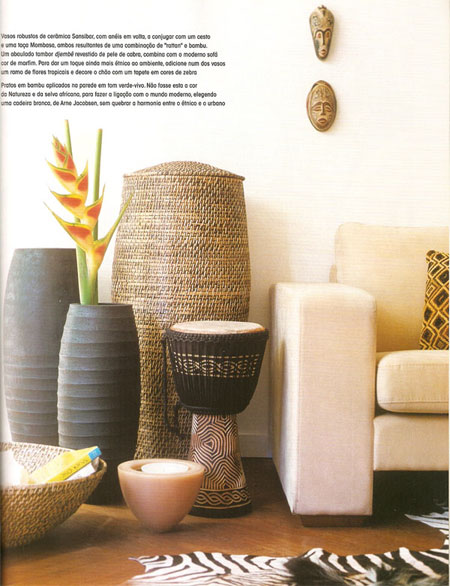
Illustration 10: Home decoration playing with cultural hybridism (Living at Home/Atlântico Press, Afro, March 2008, 2) [45]
On the other hand, images of photo models show the mixing of phenotype attributes and their systematic in-between condition (BHABHA, 2002). Not only does Afro depict, preferably "mixed-race," models hired by Portuguese fashion agencies, but also the production teams working for the magazine (photographers, hairdressers, make-up staff) play with physiognomic stereotypes to construct images of miscegenation: this is why lighter skin tones come to be pictured with voluminous curly hair, while straight hair style is given to the (rare) ones with darker skin tones (Illustration 11, set of photos in promotional articles about cosmetics, hairdressing and fashion).
|
|
|
|
Illustration 11: Photo models enhancing the aesthetics of miscegenation (Rui COSTA, Paulo LOPES, Afro, March 2008, 2 , 92/85/43 [© Afro/Impala]) [46]
This suggests cosmetic intervention to "Europeanize" darker models, and possibly the opposite kind of make-up to assure a certain level of African flavor to the lighter ones. Both in people and in objects, Afro displays a certain kind of interaction discourse, matching on the same level cultural or racial traits perceived to represent different poles. This is achieved by either verbalizing practices of fusion or visualizing them through images. [47]
This interaction discourse raises a number of questions. Is this part of an ex-colonizer aim to whiten the ex-colonized, thus accommodating the magazine to symbolic hierarchies of aesthetics linked to racist patterns of beauty and status? Is it a miscegenation strategy set in a post-colonial context? Or is it a marketing strategy, but embedded in a dominant racial ideology, believing that it may capture at the same time black audiences and mainstream advertisers? What it certainly does not appear to be is part of a movement committed to the symbolic valorization of blackness. When viewed in terms of identity politics, even though not conscious, the interaction discourse promotes the aesthetic figure of the in-between people. In this sort of text, Afro moves itself away from a difference discourse, in which Africa, Africans, African culture and even African "blood" do not equate with blackness. [48]
Afro's context is not only about post-colonial immigration and clear distinctions between Africa and Europe. It inherits notions of a colonial world, and speaks of porous borders. But this porosity allows some things more than others. It does not allow the magazine's verbal discourse to label black Portuguese as Europeans. However, it does allow people from former colonizer families to define themselves as Africans, and even to adopt for themselves some naturalizing ideas about African "soul" and "blood" (Illustration 12, feature report about businesswoman, Afro, 8, 27).

Illustration 12: In Afro features, Africanity goes beyond racial marks (Rui COSTA, Afro, November 2008, 8, 27 [© Afro/Impala]) [49]
This is where Portuguese post-colonialism takes up some ambivalence inherited from past "impure" relations between colonizers, colonized and colonial territories. Contrary to other post-colonialisms—where this woman would probably not be labeled as "African"—it is possible to find ex-colonizers in Portugal who name themselves as Africans; neglect skin color; and emphasize place of birth, lived background, cultural traits acquired in Africa and a bit of "blood" coming from a Creole grandmother. It is not by chance that post-colonialists find room to speak their Africanity in the magazine; it is the profile of Afro's managers that provides this. And that is a further reason why Africa and "race" are not always synonymous here. The "magazine for the woman of African origin" is located within the ambivalent frame of Portuguese post-colonialism. This example plays with labels in an interaction discourse, articulating white "race" with African culture. The absence of the reverse labeling (verbalizing the articulation of black "race" with European culture), however, shows the limits and asymmetries of the ideas fusion allowed by Portuguese post-colonialism, and which are to be found on the pages of Afro. [50]
7. Stories About Mixing: Layers of Discourse
The magazine is centered on features with real people (mostly celebrities and media figures), mainly supplemented with visual sequences of indirect advertising, where photo models display clothes, cosmetics or hair-styles. However, Afro also reports on topics related to the lives of its presumed audience, where it quotes ordinary people in Portuguese society. The topics covered in these articles include matters related to employment, mixed couples and miscegenation. [51]
The first characteristic I want to point to concerning these texts is their pictures. All of these pictures come from the archives of the magazine's media group. None is taken in the context of the report to add a sense of realism to the text, as is usually the case in the canon of journalism. These pictures often have a flat perspective, following the aesthetics of fashion and advertisements, showing characters in a scenario without depth, which connotes them with a realm of fantasy. Photographs of the people quoted in the article are not used, in their place are pictures of models (whose link to the report is merely illustrative or thematic) or jet-set people (who are occasionally quoted in the text, but mainly shown in pictures just as examples about the issue covered). This editorial procedure, focusing solely on photographic models and "famous" people, thus offers its audience not a mirror effect of everyday life but an idealized world of beauty, wealth and success. The photographs used in these articles are a further illustration of the increasing use of global image banks by the media. As noted by David MACHIN (2004) the images contained within these banks are ideologically pre-structured in harmony with consumerism. [52]
There is an overall contrast between the representation of Africa and that of the West. The former is shown in a limited number of images of anonymous people in common situations under the aesthetics of realism; while the latter is shown only through pictures of celebrities, fashion models and the media world. If we make a semiotic analysis of the "preferred" level of generality contained in pictures we can see further. In the text about employment, although the report quotes immigrant women from former Portuguese colonies, the photos do not depict specific individuals, but a social type (Illustration 13, main half-page photo in report about job market, Afro, 5, 95).

Illustration 13: Visual image for a social type, the middle class professional woman (Arquivo Impala, Afro, June 2008, 5, 95) [53]
Visual stereotypes—attributes that give the reader clues about which kind of people and situations are represented in a picture—play a central part in our understanding of a social type (VAN LEEUWEN, 2001). This picture includes only cultural stereotypes of urban "white collar" jobs—office desks, computers, telephones—and of Western personal marks—clothes such as trousers. So the represented type is the middle class professional. This is a further example of a photograph understating physiognomic attributes associated with Africans, only using some of them slightly (skin tone) and blending them with non-African attributes (straight hair). What is represented is woman—not the African or the black woman. Is it a deracialized woman, by way of crossing borders, offering points of identification to any middle class female reader? Or is it offering the immigrant or black female reader a creolized image of middle class professionals, telling her that access means adopting some sort of hybridization? [54]
If the physiognomic attributes of the woman depicted made prominent the African stereotype, we could say it would have connoted with assimilation: women of African origin working in white-collar jobs carrying Western urban cultural signs. But the potential meaning is rather different here, especially in articulation with the titles (reference to a "postponed dream") and the text (where all the quotes are from immigrant African women whose level of education denied them a career and restricted them to waged employment in cleaning or shops). The main photo of this text (again Illustration 13) is in contrast with such verbal discourse, connoting autonomy at work (standing and actively engaged in the use of a telephone and a computer, a large office backdrop, and no one else in the frame). Also a set of photographic conventions—the profile angle, the close but social distance, and the gaze away from the viewer—interacts with the reader as offering an ideal (KRESS & VAN LEEUWEN, 2004). This ideal is potentially one of fusion, working through blurring and deracialization. Taken together the words and the images act as a different kind of interaction discourse, because here interaction seems to allow only the verbalized idea of Africanity, but it denies visual signs of it, whether through culture or "race." [55]
Fusion discourse is also highlighted in reports about multiracial couples and "mixed-race" people. On a front cover, the British singer SEAL (it is never said in the text where he is from—he's just black) stares at the reader. He stands naked, being kissed and embraced from the back by the blonde German model Heidi KLUM. Over SEAL's naked body the headline says: "Multiracial marriages are successful" (Illustration 14).
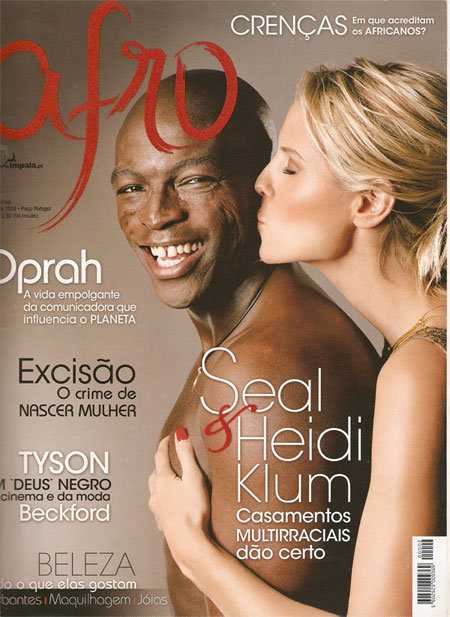
Illustration 14: Cover of Afro, 2, highlighting "mixed-race" couples (Mark LIDDELL, Iconphoto/Atlântico Press, Afro, March 2008, 2, cover) [56]
According to visual semiotics, images can offer meanings either to specific individuals or to social types by using dimensions such as distance, behavior, modality and surrounding texts (VAN LEEUWEN, 2001). In this picture, both the words and the image at close personal distance and eye level emphasize the individuality of the two characters. The uncovered skin, on the other hand, may be seen as enhancing an attribute of a social type, thus functioning as a sign of visual typification: the image shows a specific individual, but also a black man. Moreover, it shows dark skin as an object of desire, enhanced by the movement in the picture: the blonde woman grabbing the black man's chest. Images also contain interactive dimensions, involving invitations to the viewer as to how to relate to a picture (KRESS & VAN LEEUWEN, 2004). In this picture, the woman in profile offers detachment, while the man looking at the viewer directly and smiling demands affiliation. [57]
Visual popular culture deals with the pleasure of looking that articulates questions of social status with questions of sexuality (LISTER & WELLS, 2001). Afro's images show objectified bodies of successful males in athletic or languid gestures and thus may provide this kind of visual pleasure to female readers. However, by showing "black" males in multiracial couples the magazine does more than just evoke this kind of pleasure (another example in Illustration 15, opening full page photo in feature report about footballer and wife, Afro, 5, 25) ,This is because Afro addresses female readers as people "of African origin," calling for their self-identity by "race" and/or culture. The magazine simultaneously calls for their affiliation with other "Africans" and their condition as women within a frame of heterosexuality. Consequently the audiences can construct different meanings: the image may function to legitimate "mixed-race" couples in general, thus underlying the value of romantic love and freeing them of loyalties to original cultures and ethnicities; or it may function to encourage them to identify with same "race" actors and their success and good-looks; or finally it may function as a reminder about the need to improve their physical care if they want to compete with white female beauty in the love market, this last reading being underscored by a colonial ideology about hierarchical types of beauty in which white female beauty is presented as paramount.

Illustration 15: The magazine depicts several images of African male-European woman couples (Paulo LOPES, Afro, June 2008, 5, 25 [© Afro/Impala]) [58]
Nevertheless, these images invert the colonial discourse that used to highlight sexuality between the white male and the African woman, in its two versions: the ideology of difference, which pointed to the black woman as responsible for luxuriant seduction and "race" degradation; and the ideology of hybridism, with the Portuguese man as a special agent of encounter and miscegenation. In this sense it is a post-colonial miscegenation, a sort of interaction discourse that inverts the hegemonic colonialist norm on the sexual level. By not highlighting black women—white men couples, it escapes the colonialist idea about black female sexual identity being over-determined in relation to white males (SHARPLEY-WHITING, 1999, p.10). [59]
In the sequence of the cover story in which Seal is being embraced by his blonde wife there is a prominent text about the general issue of "multiracial marriages." The headline states not only couples, but marriages, generally meaning a commitment to stability as well as social and kinship acceptance. What is invoked through images of black and white couples? Depending on context and the reader, it may connote with an open, tolerant, socially democratic society in which there is no "race" discrimination. By contrast it may connote with personal courage to break racial segregation, and face social taboos. Or it may connote with the strength of love relations above all else. These possible iconographic meanings are generally recognized (VAN LEEUWEN, 2001), and could be researched among audiences. [60]
Another headline states that multiracial marriages are "increasingly frequent." This frames the issue as something positive and fashionable. It does not imply that these marriages were scarce in the past, rather it claims that they were frequent in the past and now are increasingly so. The report, voicing the experience of four couples in Portugal, frames the subject as a narrative that contrasts the problems faced by older couples and their once forbidden engagements (recalling colonial times when they met in Africa), and the ease of young couples to make families today. The text nevertheless contains some underlying assumptions about essentialized differences, such as "the Africans human warmth," and it approaches the reasons for attraction between blacks and whites, implying they are opposite poles. [61]
This text shows the multilayered levels and the complex articulations that exist between the discourses I have been using as analytical tools. A story apparently about interaction (multiracial coupling) turns out to be framed in a difference discourse sub-text. A further complexity is that while the interaction discourse is visually displayed by actors in non-hierarchical ways, it is the verbal mode that subtly assumes the existence of two naturally different poles, the opposition of which is the very reason for attraction. The text avoids labeling anyone as black ("Vânia Oliveira, 32, was born in Mozambique," Afro, 2, 76), which is a mark of the assimilation discourse outlined above. Together, these discourses show how coexistent and intertwined the several approaches to "race" and culture can be in Portuguese post-colonial times. The last section of the report is dedicated to a supposed "blacks' aversion to whites," featured by another older couple. Thus the text ends in a reassuring way for Portuguese dominant ideology, because the problems about "race" relations within the family are finally framed as due to the sometimes insufficient tolerance from both sides, not to power questions or to asymmetrical symbolic status. [62]
The underlying assumption about a natural racial fact with two contrary poles—whites and blacks—is present in other texts, as in a report about miscegenation (Illustration 16, Afro, 5, 107).
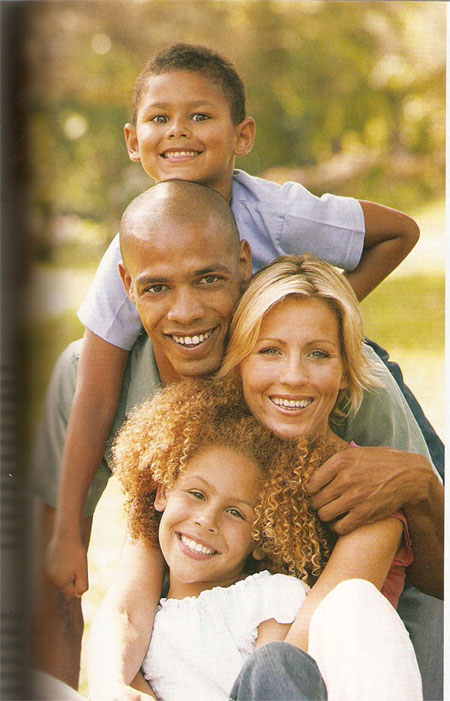
Illustration 16: Image of easy miscegenation do not anchor in verbal text about harsh experience (Arquivo Impala, Afro, June 2008, 5, 107) [63]
The title of this text is "Milk and coffee," below a heading stating: "Neither white, nor black. Mulatto!" The rigidity of racial conceptions is reinforced in the subheading, saying these are people "with no identity of their own." The text's main axis is about coping with difficult experiences, social and family pressures, crisis of identity and the need of constantly looking for reference groups. Thus the report frames miscegenation as a problem for biological hybrids themselves. The pictures oppose this discourse by showing smiling children and a set of "famous mestiços." A minor discourse within the text is about the enriching plural experience of mestiços and how they can be pioneers in respecting differences. This report is another example of the coexistence and tension between discourses of difference and discourses of fusion. [64]
Hybridity debates, according to PIETERSE (2001), illuminate where the signifying borders lie at a certain time, and what importance is socially and ideologically assigned to them. Hybridity is only noticed when it questions essentialized boundaries, and where there is "a prior cult of purity and boundaries," and a hierarchy of differences (PIETERSE, 2001, p.226). In the magazine Afro the approach of mixing, both visual and textual, is rarely about culture, and very much about "race." This suggests that the important borders for minorities in the Portuguese post-colonial context are racial ones, more than cultural ones. [65]
Behind the Portuguese post-colonial way of not naming blackness or whiteness, and not considering "race" officially, the magazine's prominent stories about "race" mixing and the systematic display of racially hybrid models implicitly indicate the significance of "race" in everyday life. The way in which "race" is approached also indicates that the interaction discourse is now the norm, and is to be socially accepted when publicly spoken by a minority. The case of Afro is particularly interesting because it is not purely a minority media made by immigrants, but rather it is owned and directed by ex-colonizers in Africa. It thus constitutes a potential space for distinct discourses and a site where Portuguese post-colonial hegemonic ideology may exercise its power and set limits for other, more contesting, ways of speaking. [66]
Afro is a site of crossing for the several discourses about "race" and culture that today coexist in Portugal . Overall, the magazine states that "race" exists, and even reinforces its existence. However, in an apparent paradox, Afro also blurs racial boundaries, by broadening the concept of Africanity. A reception study would help to, uncover what "races" connote for the audiences; and at a denotative level, help point to the racial labels (if any) the audiences assign to depicted actors. [67]
By rarely using "race" categorizations the magazine apparently refuses the difference discourse in a post-colonial Portuguese context. It softens the impact of difference by avoiding the topics of inequality and discrimination, and by often smoothing the discourse in headlines and visual images when compared to the written stories. The discourse of difference is nevertheless accommodated at another level by means of: inserting imported stories about international people labeled "black," and voicing their views on "race" relations and discrimination. The difference discourse also emerges from beneath approaches to hybridization, as a deeper consciousness. [68]
If verbal discourses of fusion do not easily overcome those about difference in the magazine, the fact is that hybridity is highlighted as aesthetic value and acts through visual modes as an articulated discourse. It is apparently difficult to express this discourse in the mode of written language. A question to address is whether visual diversity has not simply become part of the establishment and a post-modern cultural norm which is administered as a way of neutralizing politics. This is what Kobena MERCER (2002, p.196) identified as "a new regime of multicultural normalisation," a market-based normalization, where the mediatization of black image and culture does not carry critiques of social injustice but rather covers sharp inequalities within minority groups along gender and class lines. [69]
Afro is more of a media space, where some social actors can be seen and where audiences can see, than a public sphere where statements are made. Although some stories centered on actors' private lives may resonate with public issues or broad politics, they are timid when it comes to approaching "race" questions in challenging ways. Such stories neither challenge gender questions politically nor approach issues of class. [70]
Hybridism and miscegenation are fashionably presented in Afro, however, both the voiced aspirations of social actors and the magazine's background narrative convey an assimilation discourse. The main aim being proclaimed in the name of Africans is that of being accepted with no inequalities in the existing social structures of the West, be it in national TV stations, in the professional market or in the international fashion world. [71]
Assimilation discourse works through individualization and the stories of people who seem to depend solely on their individual capacities to climb the social ladder of status and citizenship. Both the scarce visual images of Africans in groups and their non-representation in settings marked by cultural difference, further underline a discourse of assimilation of the black individual. The underlying sense recalls old colonial ideas: possibilities for successful integration of black people face no serious obstacles and strictly depend on black people, as individuals, adhering to the dominant norm. [72]
The new post-colonial element is that now, as immigrants in the context of the ex-metropolis, they seem to be invited to interact and fuse with the majority and its culture. But some ambivalence remains in what this means. Is this a celebration of fusion in itself, contributing to an emergent hybrid nation? Or, is it a way to be better assimilated, erasing difference? The competition between these two discourses within Portuguese society is not going to be solved in Afro's pages, where they appear deeply intertwined. [73]
Acknowledgments
The author wishes to acknowledge the anonymous peer reviewers for the input they contributed with for the article and also Susan Ball for her precious help in editing and revising the English.
The author has made every effort to trace the owners of copyright material. In some cases, however, it has not been possible to trace the owners. The author welcomes correspondence from individuals or companies which he has been unable to trace.
1) SALAZAR was the leader of the authoritarian right wing government that presided over and controlled Portugal from 1932 to 1974. <back>
2) Data from Serviço de Estrangeiros e Fronteiras, state organization for borders control and foreign citizens: http://www.sef.pt/portal/v10/PT/aspx/estatisticas/index.aspx?id_linha=4224&menu_position=4142#0 [Accessed: October 28, 2009]. <back>
3) http:/www.youtube.com/watch?v=9ZHPiKX94u8 [Accessed: October 30, 2009]. <back>
4) Newspapers headlines respectively from Público (May 2, 2003), Público (January 15, 2004) and Crime (September 16, 2004). <back>
Alexandre, Valentim (2000). Velho Brasil, Novas Africa: Portugal e o Império (1808-1975). Oporto: Afrontamento.
Almeida, Miguel Vale (2000). Um mar da Cor da Terra: Raça, cultura e política da identidade. Oeiras: Celta.
Barthes, Roland (1957). Mythologies. Paris: Seuil.
Berger, John (2005). Modos de ver. Barcelona: Gustavo Gili.
Belanciano, Vítor (2008). O nosso 2008, Público/Ípsilon, December 12, 2008, http://ipsilon.publico.pt/teatro/texto.aspx?id=219272 [Accessed: October 28, 2009].
Bethencourt, Francisco & Chaudhuri, Kirti (1999). História da Expansão Portuguesa (Vol. 5). Lisbon: Círculo de Leitores.
Bhabha, Homi (2002). The location of culture. London: Routledge.
Boxer, Charles (1981). O Império Colonial Português (1415-1825). Lisbon: Edições 70.
Cabecinhas, Rosa (2002). Racismo e etnicidade em Portugal. PhD Thesis, Universidade do Minho, Portugal.
Carvalheiro, José R. (2008). Do Biddonville ao Arrastão: Media, minorias e etnicização. Lisbon: Imprensa de Ciências Sociais.
Castelo, Cláudia (1998). "O modo português de estar no mundo" – O luso-tropicalismo e a ideologia colonial portuguesa (1933-1961). Oporto: Afrontamento.
Fowler, Roger (1991). Language in the news: Discourse and ideology in the press. London: Routledge.
Freyre, Gilberto (1961). O Luso e o Trópico. Lisbon: Comissão das Comemorações do V Centenário da Morte do Infante D. Henrique.
Gandy, Oscar H. (2000). Race, ethnicity and the segmentation of media markets. In James Curran & Michael Gurevitch (Eds.), Mass media and society (pp.44-69). London: Arnold.
Gilroy, Paul (1995). The Black Atlantic: Modernity and double consciousness. London: Verso.
Hall, Stuart (1997). The spectacle of the Other. In Stuart Hall (Ed.), Representation: Cultural representations and signifying practices (pp.223-279). London: Open University Press.
Hanchard, Michael (1995). Black Cinderella?: Race and the public sphere in Brazil. In The Black Public Sphere Collective (Ed.), The Black Public Sphere (pp.169-189). Chicago: University of Chicago Press.
Hebdige, Dick (2005). The bottom line on planet one: Squaring up to the face. In Jessica Evans & Stuart Hall (Eds.), Visual culture: The reader (pp.99-124). London: Sage.
Henriques, Isabel Castro (1999). A sociedade colonial em África: Ideologias, hierarquias, quotidianos. In Francisco Bethencourt & Kirti Chaudhuri (Eds.), História da Expansão Portuguesa (Vol. 5, pp.216-275). Lisbon: Círculo de Leitores.
Kress, Gunther & Van Leeuwen, Theo (2001). Multimodal discourse: The modes and media of contemporary communication. London: Arnold.
Kress, Gunther & Van Leeuwen, Theo (2004). Reading images: The grammar of visual design. London: Routledge.
Lewis, Reina (2002). Looking good: The lesbian gaze and fashion imagery. In Nicholas Mirzoeff (Ed.), The visual culture reader (pp.654-668). London: Routledge.
Lister, Martin & Wells, Liz (2001). Seeing beyond belief: Cultural studies as an approach to analysing the visual. In Theo Van Leeuwen & Carey Jewitt (Eds.), Handbook of visual analysis (pp.61-91). London: Sage.
Machado, Fernando L. (2008). Filhos de imigrantes africanos no mercado de trabalho: acessos, perfis e trajectos. Migrações, 2, 121-158.
Machin, David (2004). Building the world's visual language: The increasing global importance of image banks in corporate media. Visual Communication, 3(3), 316-336.
Malonga, Marie-France (2007). Les stratégies identitaires des minorités noires face à la télévision française. In Tristan Mattelart (Ed.), Médias, migrations et cultures transnationales (pp.57-71). Brussels : De Boeck.
Matos, Patrícia F. (2006). As Côres do Império: Representações raciais no Império Colonial Português. Lisbon: Imprensa de Ciências Sociais.
Mercer, Kobena (2002). Ethnicity and internationality: New British art and diaspora-based blackness. In Nicholas Mirzoeff (Ed.), The visual culture reader (pp.190-203). London: Routledge.
Mirzoeff, Nicholas (2002). The subject of visual culture. In Nicholas Mirzoeff (Ed.), The visual culture reader (pp.3-23). London: Routledge.
Pieterse, Jan Nederveen (2001). Hybridity, so what?—The anti-hybridity backlash and the riddles of recognition. Theory, Culture and Society, 18(2-3), 219-245.
Pires, Rui P. (2003). Migrações e Integração. Oeiras: Celta.
Ross, Karen (2000). In whose image? Tv criticism and black minority viewers. In Simon Cottle (Ed.), Ethnic minorities and the media (pp.133-148). Maidenhead: Open University Press.
Russel-Wood, A. J. R. (1998). Políticas de fixação e integração. In Francisco Bethencourt & Kirti Chaudhuri (Eds.), História da Expansão Portuguesa (Vol. 2, pp.126-150). Lisbon: Círculo de Leitores.
Santos, Boaventura de Sousa (2001). Entre próspero e Caliban: Colonialismo, pós-colonialismo e inter-identidade. In Maria Irene Ramalho & António Sousa Ribeiro (Eds.), Entre ser e estar: Raízes, percursos e discursos da identidade (pp.23-85). Oporto: Afrontamento.
Sharpley-Whiting, T. Denean (1999). Black Venus: Sexualized savages, primal fears and primitive narratives en French. Durham, NC: Duke University Press.
Vala, Jorge (Ed.) (2003). Simetrias e identidades: Jovens Negros em Portugal. Oeiras: Celta.
Vala, Jorge; Brito, Rodrigo & Lopes, Diniz (1999). Expressões dos racismos em Portugal. Lisbon: Imprensa de Ciências Sociais.
Van Dijk, Teun (1997). Semântica do discurso e ideologia. In Emília Pedro (Ed.), Análise crítica do discurso (pp.105-168). Lisbon: Caminho.
Van Leeuwen, Theo (1997). A representação dos actores sociais. In Emília Pedro (Ed.), Análise crítica do discurso (pp.169-222). Lisbon: Caminho.
Van Leeuwen, Theo (2001). Semiotics and iconography. In Theo Van Leeuwen & Carey Jewitt (Eds.), Handbook of visual analysis (pp.92-118). London: Sage.
Young, Robert (1995). Colonial desire: Hybridity, theory, culture and race. London: Routledge.
José Ricardo CARVALHEIRO is Assistant Professor in the Communication and Arts Department of the University of Beira Interior, Portugal. His academic background is in sociology and media studies. He is interested in subjects relating to media, culture, migration and minorities.
Contact:
José Ricardo Carvalheiro
Universidade da Beira Interior
Departamento de Comunicação e Artes
Rua Marquês D'Ávila e Bolama, 6200-001 Covilhã
Portugal
E-mail: jr.carvalheiro@gmail.com
Carvalheiro, José Ricardo (2010). Is the Discourse of Hybridity a Celebration of Mixing, or a Reformulation of Racial Division? A Multimodal Analysis of the Portuguese Magazine Afro [73 paragraphs]. Forum Qualitative Sozialforschung / Forum: Qualitative Social Research, 11(2), Art. 24, http://nbn-resolving.de/urn:nbn:de:0114-fqs1002247.